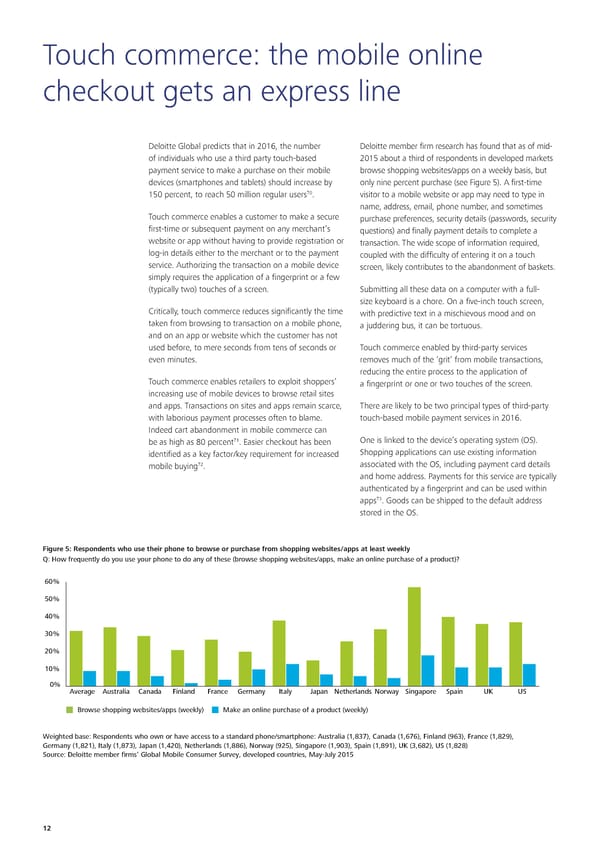Touch commerce: the mobile online checkout gets an express line Deloitte Global predicts that in 2016, the number Deloitte member firm research has found that as of mid- of individuals who use a third party touch-based 2015 about a third of respondents in developed markets payment service to make a purchase on their mobile browse shopping websites/apps on a weekly basis, but devices (smartphones and tablets) should increase by only nine percent purchase (see Figure 5). A first-time 70 150 percent, to reach 50 million regular users . visitor to a mobile website or app may need to type in name, address, email, phone number, and sometimes Touch commerce enables a customer to make a secure purchase preferences, security details (passwords, security first-time or subsequent payment on any merchant’s questions) and finally payment details to complete a website or app without having to provide registration or transaction. The wide scope of information required, log-in details either to the merchant or to the payment coupled with the difficulty of entering it on a touch service. Authorizing the transaction on a mobile device screen, likely contributes to the abandonment of baskets. simply requires the application of a fingerprint or a few (typically two) touches of a screen. Submitting all these data on a computer with a full- size keyboard is a chore. On a five-inch touch screen, Critically, touch commerce reduces significantly the time with predictive text in a mischievous mood and on taken from browsing to transaction on a mobile phone, a juddering bus, it can be tortuous. and on an app or website which the customer has not used before, to mere seconds from tens of seconds or Touch commerce enabled by third-party services even minutes. removes much of the ‘grit’ from mobile transactions, reducing the entire process to the application of Touch commerce enables retailers to exploit shoppers’ a fingerprint or one or two touches of the screen. increasing use of mobile devices to browse retail sites and apps. Transactions on sites and apps remain scarce, There are likely to be two principal types of third-party with laborious payment processes often to blame. touch-based mobile payment services in 2016. Indeed cart abandonment in mobile commerce can 71 One is linked to the device’s operating system (OS). be as high as 80 percent . Easier checkout has been identified as a key factor/key requirement for increased Shopping applications can use existing information 72 associated with the OS, including payment card details mobile buying . and home address. Payments for this service are typically authenticated by a fingerprint and can be used within apps73. Goods can be shipped to the default address stored in the OS. Figure 5: Respondents who use their phone to browse or purchase from shopping websites/apps at least weekly Q: How frequently do you use your phone to do any of these (browse shopping websites/apps, make an online purchase of a product)? 60% 50% 40% 30% 20% 10% 0% Average Australia Canada Finland France Germany Italy Japan Netherlands Norway Singapore Spain UK US Browse shopping websites/apps (weekly) Make an online purchase of a product (weekly) Weighted base: Respondents who own or have access to a standard phone/smartphone: Australia (1,837), Canada (1,676), Finland (963), France (1,829), Germany (1,821), Italy (1,873), Japan (1,420), Netherlands (1,886), Norway (925), Singapore (1,903), Spain (1,891), UK (3,682), US (1,828) Source: Deloitte member firms’ Global Mobile Consumer Survey, developed countries, May-July 2015 12
 Technology, Media & Telecommunications Predictions Page 16 Page 18
Technology, Media & Telecommunications Predictions Page 16 Page 18